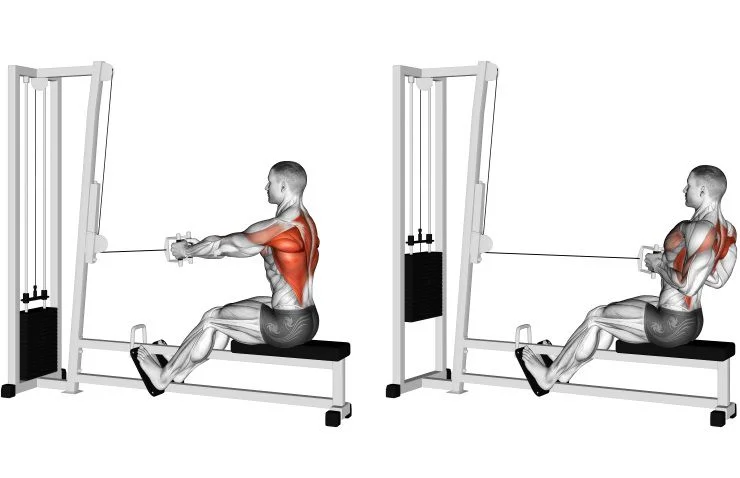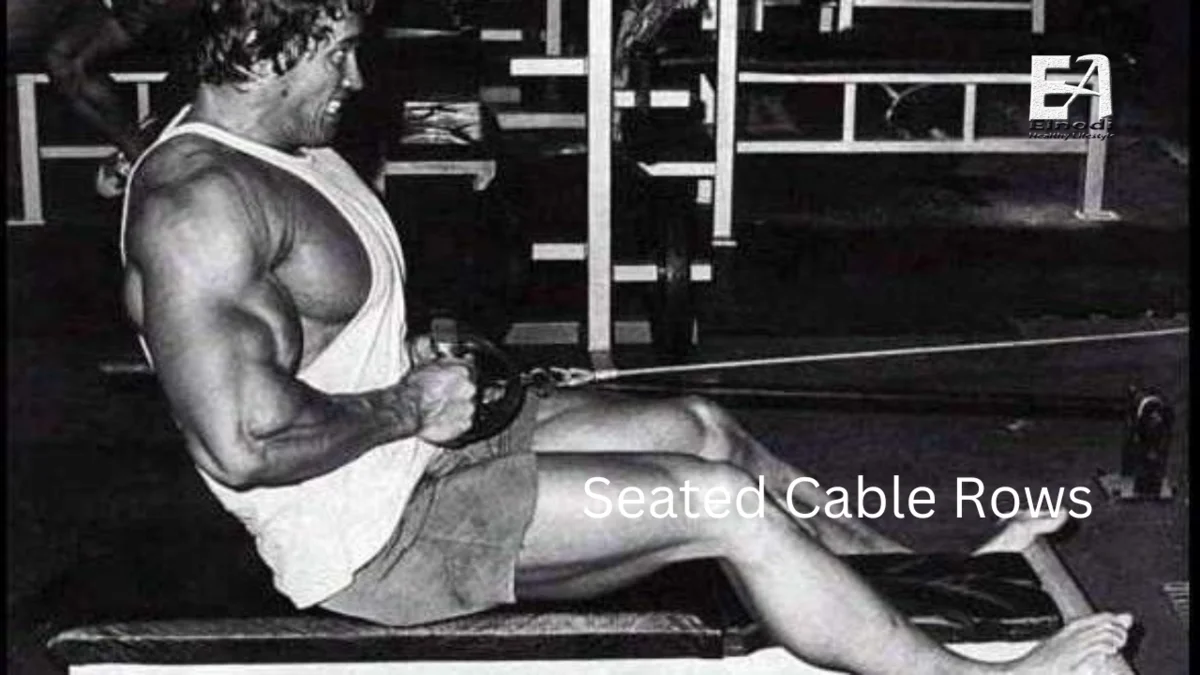Try seated cable rows! They provide your complete back with a tremendous workout, resulting in a stronger and more elastic spine. Include seated cable rows in your workout! This traditional exercise exercises the entire back, from the shoulders to the hips. (1)
What are Seated Cable Rows?
Seated cable rows target the latissimus dorsi (lats), rhomboids, and trapezius muscles in the back. It is done on a cable machine seated with a V-bar or straight bar attachment.
benefits of Seated Cable Rows
Prevents Back Pain
Because it strengthens the upper back muscles, this is a fantastic exercise to do to avoid back pain. 1 Exercises that strengthen the muscles in your backside (known as posterior chain muscles) are more beneficial than general exercise in treating lower back pain.2
Develops Strength
This is a strength-building exercise rather than an aerobic rowing exercise. Even though it is called a row, it is not the traditional action performed on an aerobic rowing machine. It is a useful exercise because you bring items toward your chest several times during the day.
Prevents Injury
Strong latissimus dorsi muscles help to shoulder stability. This can aid in the prevention of injury in this area.3Shoulder injuries are common in sports involving overhead motions, such as basketball, baseball, several track and field sports, volleyball, tennis, lacrosse, and others.
Improves Throwing Ability
Using the sitting cable row to build shoulder muscles might help you acquire power when throwing objects. This is useful for those who compete in throwing sports, but it can also be useful in everyday tasks.
Prepares You For Other Exercises
Using your core and legs while keeping your back upright might help you avoid strain and injury. This straight-back, ab-engaged technique is also used in squat and deadlift workouts.
Muscles worked by the Seated Cable Rows

Lats
The latissimus dorsi, or lats, are what most people think of when they think of “a big, muscular back.” The muscle runs from under the shoulders down to the waist, with the developed muscle being visible under the arms near the ribs. The lats are worked during the seated cable row when your elbows pull the weight towards your body, causing a powerful contraction on both sides of the body. (2)
Upper Back
The upper back refers to the area of the back that runs from shoulder to shoulder between the neck and shoulder blades. It is made up of multiple muscles, including the back deltoids, teres, rhomboids, and trapezius. During the seated cable row, these muscles are activated when the scapulae (shoulder blades) pull inwards while lifting the weight.
Biceps
The biceps aren’t the primary muscle lifting the weight in a seated cable row, and they shouldn’t be, but they are heavily worked during the exercise. When you bend your arm to draw the handle closer to your body, your biceps participate in the movement. The movement is also supported by the smaller forearm and grasping muscles, as they are in any “pulling” exercise. (3)
how to do Seated Cable Rows

Instructions
- Attach a close-grip bar or V-bar to the seated row machine and place the proper weight on the weight stack.
- Using a neutral grip (palms facing in), grasp the bar.
- Pull the weight up slightly off the stack while keeping your legs slightly bent and your back straight. You should be sitting straight up and back, shoulders back. This is your starting point.
- Pull the handle into your tummy while keeping your body in place.
- Pull your shoulder blades back, squeeze, halt, and then slowly return to the beginning position.
- Repeat for the appropriate number of reps.
Tips
- Your back should be straight at all times. Throughout the set, your torso should remain stationary.
- When your arms are extended, don’t hunch your shoulders.
- To move the weight, use your back muscles rather than leaning forward and swinging the weight back.
- Pausing and squeezing for a 1-2 count at the top of the movement will improve intensity and outcomes.
common mistakes
- Elbows turned outward. During the pulling phase (save for the wide-grip row), keep your elbows against your body. Lifting your elbows up and out engages the biceps rather than the lats and rhomboids.
- Shoulders shrugged. Keep your shoulders back and down as you draw the weight. Shrugging your shoulders toward your ears will draw attention to the traps.
- Back rounded. Maintain a neutral back position at all times. Engage your abdominals and keep your spine straight to avoid rounding or arching.
- Torso swinging. Keep your torso still. Otherwise, the targeted muscles will not be tense. During the exercise, brace your core to assist stabilize your torso.
- Quick motions. Perform each rep gently to completely stimulate your muscles. Avoid abrupt and quick movements.
- Partial range of motion. Each rep should go through the full range of motion for optimal benefits. While a reduced range of motion lets you lift more weight, partially extending your arms won’t properly work your muscles.
- Locked knees. Locking your knees is stressful on the joints, so it’s best to slightly bend your knees.
Safety and Precautions
If you have a current or previous shoulder or lower back injury, proceed with caution. You should consult with your doctor to see if it is necessary. If you experience any sharp discomfort, stop the workout.
Seated Cable Rows Variations
Long Bar Attachment

When using a straight pulldown bar or a long bar, you can use either a palms-up (supinated) or a palms-down (pronated) grip. A supinated grip will exercise the biceps more, although a pronated grasp may be more comfortable for your shoulders, particularly if you utilize a broader grip (outside shoulder width).
A supinated grip also allows the user to pull the bar more efficiently to the lower abs or waist, which reduces upper back recruitment and can increase lat activation. A pronated grip allows you to pull the bar much higher, to chest or neck level, which decreases lat recruitment and increases muscular stress on the entire upper back.
Rope Attachment
The wrists can rotate throughout the movement by attaching a rope handle, which is more typically utilized for triceps exercises. This liberation decreases joint tension. When opposed to a solid metal handle, the rope’s flexibility provides for a slightly wider range of motion during peak contraction.
Rope rows, like the long bar, can be performed low to the hips for enhanced lat stress. The rope attachment is frequently used for pulls to the neck or eye level, also known as “face pulls.” This exercise targets the upper back and shoulder stabilizer muscles first.
Single-Arm Cable Row
Attaching a single handle and rowing with one arm at a time offers several benefits. Like all unilateral upper body exercises, the overall core activation is increased, specifically the obliques and rotational stabilizers.
A single-handle attachment, like the rope attachment, allows your wrist to spin freely during the workout. This can reduce joint stress by encouraging the elbow to move with less constriction.
Instead of bracing yourself on the bench seat, you can perform the single-arm cable row while standing. Because of the enhanced total-body recruitment, this variant may have more athletic carryover. It has also been demonstrated to increase core strength significantly.
seated Cable Rows Alternatives
Barbell Row
The barbell row is regarded as one of the “big basics” – essential exercises like the squat, deadlift, bench press, and shoulder press that assist to create a foundation of strength from head to toe.
Lifters can possibly move substantial weight with the barbell row, which can have a big impact on muscle size and raw power. However, because of the body’s posture, the lower back is subjected to far greater direct stress.
Dumbbell Row
The dumbbell row is most often performed by lying on a flat bench and moving one dumbbell. Using two dumbbells from a standing position, on the other hand, can be a useful option.
The dumbbell row is an effective balance of lower back support while also providing a full stretch and contraction for a strong muscle-building stimulus.
Chest-Supported Row
The chest-supported row is one of the most effective back exercises to drastically reduce lower back involvement because the torso is fully supported on a bench and movement is unavoidably strict with no swinging.
This variation can be performed on a particular chest-supported row bench or with a pair of dumbbells while laying chest-down on a high-angle bench.
How to Program the Seated Cable Row
The seated cable row can be configured in a variety of ways to meet a lifter’s goals and specific needs. The exercise is not well-suited to highly heavy, low-rep programming due to body position and required technique.
Moderate Weight, Moderate Repetition
One of the most common and effective approaches to program this exercise is to reach muscle failure in the 8 to 12-rep range for three or four sets using a classic bodybuilding-style approach.
Light-to-Moderate Weight, High Repetition
The continual tension of the cables helps lifters to achieve considerable muscle-building results without relying on heavy, low-rep loading. Using two to three sets of 12 to 20 reps can be an effective workout to “burn out” the back, especially when the muscles are exhausted from earlier labor.
Who Should Do the Seated Cable Rows
The seated cable rows increase muscular size while putting less strain on the lower back and shoulders. As a result, the exercise is beneficial to a wide range of lifters.
Lifting for Muscle
When it comes to building a muscular back, the sitting cable row can be really beneficial. When compared to free-weight (barbell or dumbbell) rows, which might decrease stress due to gravity-altering leverage in different positions, the cable delivers consistent strain, putting the muscle under more total stress.
Lifters with Back Pain
A seated cable row is a good option for lifters suffering from lower back pain since it allows them to train effectively without requiring a lot of weight. In addition, compared to a rowing machine, the cable allows for a more flexible joint configuration, making it a better option for lifters suffering from shoulder or elbow problems.
Summary
Seated cable rows are an excellent back exercise. It can be trained with a variety of rep ranges. It is beneficial to athletes of all skill levels. It is advisable to train the sitting cable row with moderate to heavy loads to near failure.
Alternatively, for optimum back growth, choose moderate to low loads to failure. When combined with strong compound pulling exercises such as deadlifts, bent-over rows, chin-ups, and pull-ups, seated cable rows can be a potent stimulus for fully developing your back muscles.
FAQs
Do you use your feet in rowing?
are seated cable rows worth it?
which seated cable row is best?
What is the difference between grips on row machines?
References
1. Ronai, P. (2019). Do it right: the seated cable row exercise. ACSM’s Health & Fitness Journal, 23(4), 32-37.
2. Saeterbakken, A., Andersen, V., Brudeseth, A., Lund, H., & Fimland, M. S. (2015). The effect of performing bi-and unilateral row exercises on core muscle activation. International journal of sports medicine, 900-905.
3. Cronin, J. B., Jones, J. V., & Hagstrom, J. T. (2007). Kinematics and kinetics of the seated row and implications for conditioning. The Journal of Strength & Conditioning Research, 21(4), 1265-1270.





